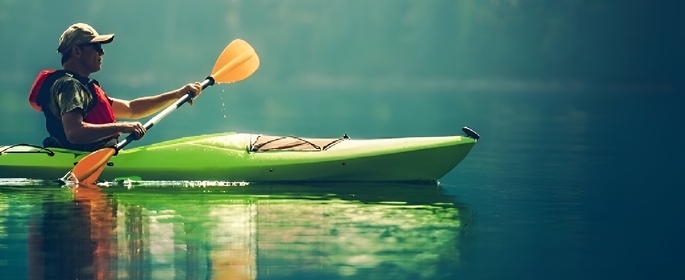Author: PaddleZone Date Posted:23 February 2024
10 Stand-Up Paddle Board Tips
Stand-up paddle (SUP) boarding, a modern water sport with roots in surfing, is a great way to soak up the sun and explore Australian waterways. Here, leisure joins forces with fitness to offer a water-sports experience like no other. Before you hit the water, it’s important to stay safe and make sure you’re comfortable with the paddling conditions and various do’s and don'ts.
Today, we’re here to give you ten helpful stand-up paddle board tips. Throughout this article, we’ll look into SUP safety, comfort, and how to get the most out of your stand-up paddle boarding adventure.
1: Choosing the Right Board
Selecting the right stand-up paddle board is the most important step for everyone, especially if you’re a beginner. This initial purchase decision will significantly influence your overall experience on the water. Ask questions first: do I need a rigid or an inflatable SUP. What are the pro’s and con’s of each and which is most suitable to the following considerations:
- What are my transport and storage considerations? Do I have space at home,need roof racks or can I walk to the water carrying my board?
- What level of experience do I have: novice, intermediate or advanced?
- What sort of water am I going to be paddling, bay, river, lake, surf, ocean?
- Will most paddling be recreational or more touring and distance?
To find the right level of stability, versatility, and safety, consider the following tips:
- An all-around paddle board caters to various water conditions.
- A touring board is usually longer and narrower so a bit more experience is required
- A Yoga style board is great for balancing and exercising
- A surf board requires experience as they’re shorter and turn or edge quickly on a wave when riding
- Pay attention to the thickness and volume of the board, and align it with your body type, weight and paddling experience.
- Speak to an expert at your local paddling store.They will have the knowledge and experience to help you select the right SUP!
2. Paddle Handling
Proper paddle handling is fundamental to a successful SUP experience. Correct techniques not only improve your paddling efficiency, but also contribute to a smoother and more stable ride. Here are essential tips to master paddle handling:
- Ensure the paddle length is suited to you. Most paddles are adjustable.
- The paddle blade should be bent away from you,this allows you to make more efficient strokes.
- Maintain proper hand placement for effective and comfortable paddling.
- Utilise a paddle leash to prevent the paddle from drifting away if you fall off your SUP.
3. Getting on board
- Start out in calm and relatively shallow water - you’ll find this initially reassuring.Climb on your SUP, begin by sitting on the board facing the bow or nose or kneel in the centre of the board. Your knees should be about shoulder-width apart to assist with balance. Keep your paddle across the board just in front of you so you can pick it up or balance on it if needed.
- Have a look around, try to keep your head up and not look down at the board or the water. To begin, pick up the paddle and slowly start to paddle on one side a few strokes then alternate. Stay on your knees to get a feel for the way the board sits in the water and responds to your paddle strokes.
- From kneeling, gently roll your toes under, place one foot on the board and then the other. Use the paddle for balance, keep it out in front of you, again try not to look down, as this will put you off balance. Slowly stand up and hold that position to get your balance.
4. Take it Slow
For newcomers, we always recommend easing into stand-up paddle boarding with a careful and gradual approach. Instead of rushing into standing positions, take the necessary time to acclimatise yourself with the board. Here are some tips for a smooth entry into the sport:
- Startyour paddling with a few strokes on each side to get your balance and some forward movement
- As your balance increases and you get a little faster, you can alternate left and right side strokes more frequently
- Practice turning left and right with a stronger stroke on on side and feel and see how the board reacts to your stroke pressure
- Continue this process and gradually extend your paddling time and distance
5. Safety First
Just like kayaking, jet skiing or boating, on a SUP safety is always a major priority for anyone planning to get on the water. A crucial element of safety is using a leg leash. Not only does it prevent separation from your board during challenging conditions, but it also provides peace of mind. Here are tips for making the most of your SUP leg leash:
- Always use a leg leash to stay connected to your board, especially in unpredictable conditions.
- Choose a high-quality leash designed to withstand different paddling scenarios.
- Fasten the leash securely in a way that can also be quickly unfastened in an emergency.
- Most boards are supplied with a leash, ask instore if you’re not sure on the correct way to attach and use a leash. You should always use a leg leash to stay connected to your board.
- Consider wearing a Personal Flotation Device (PFD ). It may be law in some States and Territories - check instore or with your local Waterways Authority.
6. Find the Right Location
Selecting the right paddling location is key, especially for beginners. Take it slow and practice in calm waters that present as few challenges as possible. By the same token, avoid ocean environments where conditions may be rough and volatile, unless you are an experienced paddler in these conditions. This will allow you to build confidence and skill gradually.
Consider the following tips for choosing the most suitable paddling locations:
- Always paddle to your experience and ideally with someone else - it’s more fun too.
- Begin in calm lakes, rivers or bays to avoid challenging currents and waves.
- Save more dynamic conditions (such as surfing bigger waves or windy days) for later when you're more comfortable.
- Develop an understanding of water flow and power before testing the waters in more challenging settings.
7. The Importance of Stability and Personal Space
Stability on your board is vital for your comfort, safety, and overall SUP experience. Additionally, giving yourself enough space on the water contributes to a safer paddle boarding environment. Here are tips for maintaining stability and personal space:
- Keep your head up to maintain stability and avoid imbalance during your paddling sessions.
- Provide ample space between yourself and other paddle boarders, minimising the risk of collisions.
- Avoid busier locations that are full of swimmers, jet skis or boats.
- Keep an eye out for other paddlers or people in the water to avoid collisions
8. Falling Safely - A Crucial Skill
Even for the most experienced paddler, falling is an inevitable part of stand-up paddle boarding, but knowing how to fall safely is a valuable skill. Here are tips for falling away from the board to minimise injuries:
- Practice falling away from the board to avoid collisions and injuries. Step backwards and fall off the back of the board for example.
- Utilise a leg leash to keep the board nearby during falls, preventing separation.
- View falling as a learning experience that contributes to your overall skill development.
9: Core Engagement for Efficient Paddling
Efficient paddling involves engaging your core muscles. This section explores why core engagement is crucial for balance, power, and endurance during stand-up paddle boarding. Here are tips for optimising your core engagement:
- Focus on using your core muscles rather than relying solely on your arms for paddling.
- Keep your knees slightly bent and your head up. This will help your balance
- Experience greater efficiency in paddling, improved balance, and enhanced endurance, as you paddle more frequently, you’ll get better at it and have more fun.
- Enjoy a low-intensity workout that builds core strength and contributes to muscle definition in your midsection.
10: A Few Essential Items to Bring Along
To ensure a hassle-free paddle boarding experience, it's essential to bring the right items. This final section highlights necessities to enhance your comfort and safety on the water. Here are tips for bringing essential items:
- Use a waterproof bag attached to your board to carry essentials like bug spray, sunscreen, car keys, and a phone.
- Always wear the right UV clothing including a hat to protect yourself from the sun. If it’s a cooler day, wear another layer of clothing and ensure you have dry clothes back on shore to change into.
- Keep hydrated, paddling can be tiring and it’s essential you keep your energy level up.
Not quite sure what to wear? Read our recent article on clothing right here!
Enjoy Your SUP Experience!
SUP’s are a great way to exercise and explore Australia’s beautiful waterways. By following these tips, you can get the most out of your stand-up paddle board experience, all while staying as safe and comfortable as possible. From here, all that’s left is to get into your zone at PaddleZone.
If you’re still a little unsure or simply need a bit of guidance, it also never hurts to turn to the experts.
PaddleZone: Your Home for SUPs in Australia
Perfect for cruising rivers, lakes, and coastal waters, stand up paddle boards offer an excellent recreational activity, the perfect opportunity for sightseeing, and a workout that gets your whole body moving.
Explore the current range of stand up paddle boards for sale from PaddleZone and chat with our team to find the best board for your needs. We’ve got top-of-the-line SUPs from Shark and ECS.
And if you’re interested in something a little different from SUPs, we also have a great collection of kayaks for sale.


